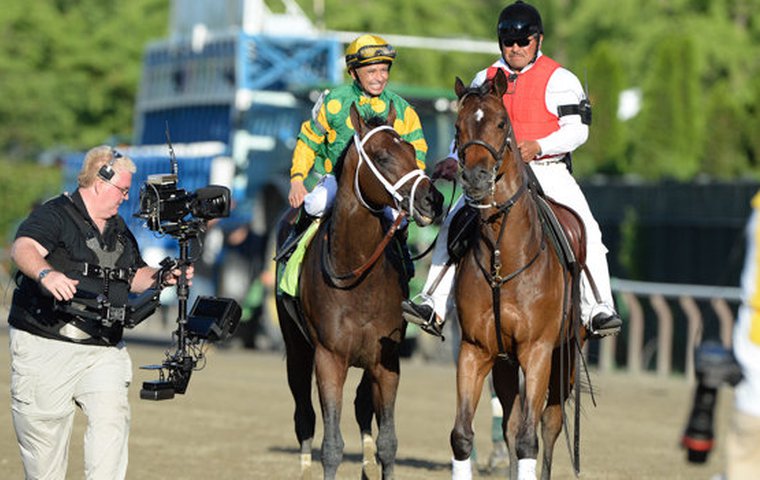
To capitalize upon an expanded presence on national television, award-winning producer Stu Kirshenbaum argues that American Thoroughbred racing telecasts must do more to encourage viewers to gamble.
In recent years, horse racing in the United States has enjoyed considerably more airtime on national television. Several industry organizations – among them, The Jockey Club, The New York Racing Association, Inc., and Keeneland – have advanced this cause and deserve great credit. But racing must do more than simply “be on TV.” Racing must ask:
- Why do we want to be on TV?
- What are our goals?
- How will this investment benefit us, both short term and long term?
Some say these questions have been answered; that the goal of additional races on TV is to create more "fans" for the "sport." In fact, TV races should endeavor to create horseplayers, not fans, and the concept of racing as a sport must be reconsidered.
These concepts are related – even as racing’s social media presence is growing, traditional media rarely treats racing as a sport save for the Triple Crown and Breeders’ Cup. Once the telecast ends, that hoped-for new fan is basically on his or her own. There is little or no mainstream media follow up, and scant day-to-day racing coverage in the national press. Absent that sort of continuity, no TV show, no matter how well-produced, is likely to create new “fans.”
Thus, for this to become a wiser, more strategic investment, the TV presentation must aggressively try to sell racing’s product (increasing betting handle), both on the televised races, and in the future. To paraphrase a former President: It’s the gambling, stupid!
Racing’s bottom line relies not on passive behavior (fans observing the action), but on participatory behavior (gambling). Therefore, racing telecasts must do much more to encourage that participatory behavior. A three-step approach could help accomplish this:
1) Show the racetrack as a fun destination.
The first step in making someone a horseplayer starts with getting that person to a racetrack. So, produce a quick travelogue, showing all the fun to be had, both in and around the track (the beach at Del Mar, Broadway in Saratoga, etc.). And use roving hand-held cameras to pepper the telecast with shots of people - across all demographics - having fun at the track.
The concept of fun at the racetrack cannot be over-promoted. Those of us who love racing love it in part because a day at the track is fun. And, save for the Kentucky Derby, fun is in dreadfully short supply on virtually every racing telecast.
Follow Major League Baseball’s lead. While they’re not selling a gambling experience, they are selling fun. A baseball telecast is a three-hour commercial for the live, in-stadium experience, filled with shots of people - across all demographics - having fun. Their telecasts have a clear goal: drive business to the ballpark. And it’s working – the past 10 seasons, 2004 - 2013, are MLB’s most highly attended ever.
2) Encourage viewers to play today.
If you’re watching televised racing on the couch and can’t get to the track, that doesn’t mean you can’t wager. Consider the many casual viewers who tune in to the Kentucky Derby every year. Then, borrow from CNBC’s playbook – their financial experts discuss puts, calls, shorts, etc. Likewise, racing’s TV experts should use the language of the racetrack: debating track bias, value, how to craft an intelligent bet, etc. Of course, certain things will have to be defined, and explanatory graphics will be required, but people will join in if you engage them. It shouldn’t be difficult to pique the interest of an already captive audience.
3) Promote account wagering.
“Sorry you can’t be with us here at beautiful Keeneland, but you can still get in on the action. It’s fun, legal, and secure.”
Incentivize viewers to open an Advance Deposit Wagering (ADW) account. Work with industry partners to create a simple website with a drop-down menu. From that menu, viewers can choose their location and be linked directly to a list of ADWs that they can legally access. If you open a new account during the first half hour of the telecast, you get $10 in free bets, plus you’re automatically entered to win a trip to an upcoming major racing event (Kentucky Derby, Breeders’ Cup, etc.).
Now, everything flows from a central theme. For today, the show promotes betting on the races on TV. For tomorrow, the show promotes getting people to the track. The consistent message remains: “Try this. It’s fun!”
Some will find this too complex and advocate that racing telecasts continue to employ the “dumbed down” approach, which is highly illogical. Encouraging viewers to handicap means asking them to eventually study the Daily Racing Form, not the Dead Sea Scrolls.
Racing is a gambling game. Gambling is not a dirty word; rather it is racing’s economic lifeblood. It’s the product racetracks sell. So shouldn’t racing use TV time strongly encouraging people to buy its product?
---
Stu Kirshenbaum has won five Sports Emmys as a Producer with ESPN, and Major League Baseball. Prior to that, he was Coordinating Producer of FOX Sports Net’s “Thoroughbred World.”


